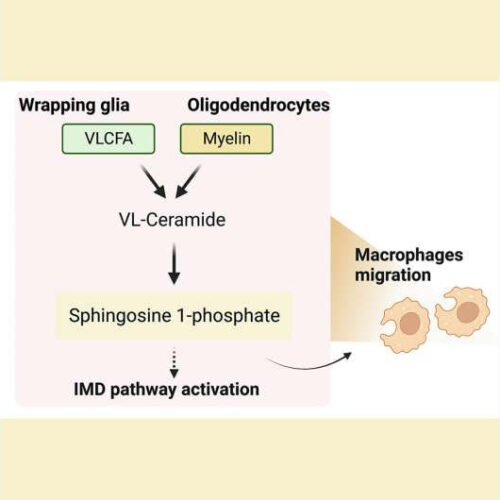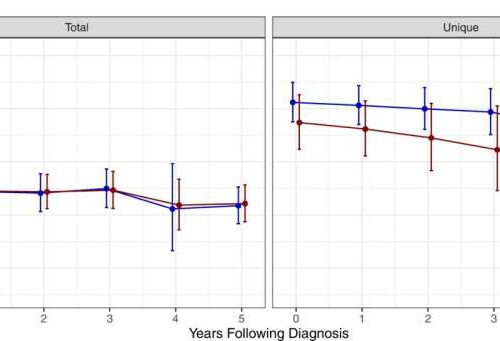by American Academy of Neurology Credit: Pixabay/CC0 Public Domain The drug atogepant may help prevent migraines for people who have had no success with other preventive drugs, according to a preliminary study released April 20, 2023, which will be presented at the American Academy of Neurology’s 75th Annual Meeting being held in person in Boston and live...
Study reveals a novel biomarker, potentially improved therapy for MS and related neurodegenerative disorders
by Texas Children’s Hospital Credit: Cell Metabolism (2023). DOI: 10.1016/j.cmet.2023.03.022 Degeneration of myelin, an insulating sheath required for rapid communication between nerve cells, and neuroinflammation are notable hallmarks of Multiple Sclerosis (MS) and related neurodegenerative disorders such as Alzheimer’s disease and Huntington’s disease, which affect roughly 2.8 million people in the world. However, little is known about...
New use for synthetic platelets: treating inherited bleeding disorders
SCIENCE & TECHNOLOGY NEWS Even as biomedical engineer Anirban Sen Gupta refines artificial platelets to stem traumatic bleeding, he and his colleagues are seeking new uses for their synthetic solution. Performing blood test in a lab. Image credit:Louis Reed via Unsplash, free license The latest application to show promise involves providing synthetic platelets to treat a genetic condition that...
Moffitt researchers discover pathway critical for lymphoma development
H. LEE MOFFITT CANCER CENTER & RESEARCH INSTITUTE TAMPA, Fla. — MYC proteins are important regulators of cancer cell growth, proliferation and metabolism through their ability to increase the expression of proteins involved in these processes. Deregulation of MYC proteins occurs in more than half of all cancers and is associated with poor patient prognosis and...
Astrocyte dysfunction causes cognitive decline
WEILL CORNELL MEDICINE IMAGE: SYNAPSES ARE COMPOSED OF PRESYNAPTIC AND POSTSYNAPTIC TERMINALS (BLUE) AND ARE CONTACTED BY ASTROCYTES (PURPLE), A CRUCIAL NON-NEURONAL CELL TYPE. DEMENTIA-ASSOCIATED PROTEIN BUILDUP IN ASTROCYTES CAUSES ABNORMAL RELEASE OF IMMUNE FACTORS (ORANGE) THAT DISTURB PRESYNAPTIC FUNCTION AND CAUSE NEURONAL HYPERACTIVITY AND COGNITIVE DECLINE IN MICE CREDIT: ORIGINAL 3D BY BROKENGRID People...
Study finds new pathway for clearing misfolded proteins
Peer-Reviewed Publication STANFORD UNIVERSITY Misfolded proteins are toxic to cells. They disrupt normal functions and cause some age-related human degenerative diseases, like Alzheimer’s, Parkinson’s, and Huntington’s diseases. Cells work constantly to eliminate misfolded proteins, but these clearance mechanisms are still poorly understood. In a new study published April 20 in Nature Cell Biology, researchers at Stanford University discovered...
Cracking the case of mitochondrial repair and replacement in metabolic stress
SALK INSTITUTE IMAGE: MITOCHONDRIA IN THE CELL DURING METABOLIC STRESS. HIGH INCREASES IN THE NUMBER OF MITOCHONDRIA (RED), MEDIUM INCREASES (GREEN), AND LOW INCREASES (BLUE). CREDIT: SALK INSTITUTE LA JOLLA (April 20, 2023)—Scientists often act as detectives, piecing together clues that alone may seem meaningless but together crack the case. Professor Reuben Shaw has spent nearly two...
Antibiotics after breast cancer linked to poorer survival, study finds
by Krista Conger, Stanford University Medical Center Landmarking analysis to evaluate the impact of antimicrobial exposure on survival over time on N = 772 independent patients. Data were presented as the hazard ratios ± 95% confidence intervals that reflect the risk of ongoing antimicrobial exposure at yearly intervals post-diagnosis and are plotted for the cumulative exposure definitions of total and...
Sugar rush: scientists discover key role of glucose in brain activity
GLADSTONE INSTITUTES IMAGE: SCIENTISTS FROM GLADSTONE AND UCSF HAVE SHED LIGHT ON EXACTLY HOW NEURONS CONSUME AND METABOLIZE GLUCOSE, WHICH COULD HAVE IMPLICATIONS FOR UNDERSTANDING NEURODEGENERATIVE DISEASES. SEEN HERE ARE KEN NAKAMURA (LEFT), YOSHI SEI (CENTER), AND MYRIAM CHAUMEIL (RIGHT). CREDIT: PHOTO: MICHAEL SHORT/GLADSTONE INSTITUTES SAN FRANCISCO, CA—April 18, 2023—The human brain has a sweet tooth,...
Wearable patch can painlessly deliver drugs through the skin
by Anne Trafton, Massachusetts Institute of Technology MIT researchers have developed a wearable patch that applies painless ultrasonic waves to the skin, creating tiny channels that drugs can pass through. Credit: Chia‐Chen Yu et al The skin is an appealing route for drug delivery because it allows drugs to go directly to the site where they’re...







